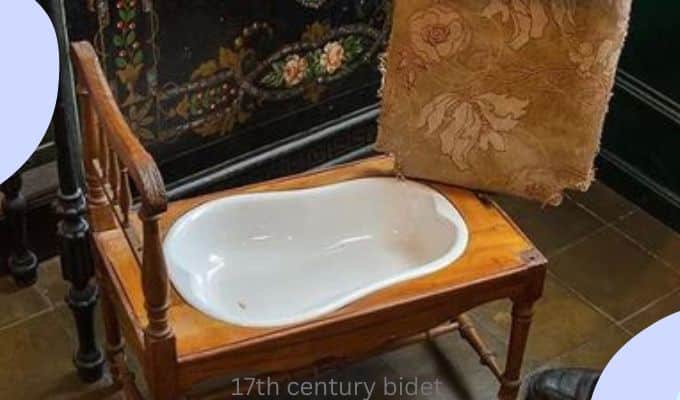A Beif History of Bidet and its Evolution around the World.

Many of you have visited South America, Japan, and the grand hotels of Paris. In their bathrooms, you may have noticed plumbing fixtures that look much like toilets and have a deep oval shape with some advanced features. These oval-shaped sanitary wear are the bidets pronounced as (Bu-day).
The bidet’s history and evolution tell a lot about the ancient concept of cleansing. Let’s look at a detailed explanation of the bidet, its history, and how it evolved into today’s advanced and multifunctioning bidet.
Who in invented first bidet?


Early around 1500B.C, people used to clean themselves in the public bathtubs. In many religions, it is necessary to use water to clean themselves. So, the use of water to clean has a long history.
Roman uses a wet sponge called “Tersorium” to clean themselves. Water was considered a hygienic way to keep themselves neat and clean and eliminate all diseases.
The practice of cleaning one’s private parts with a bowl of water was prevalent, and around the 1700s French invented a structure that held water and could be used for such cleaning purposes. Initially that structure was made up with wood and it only royal family used it.
Bidet History in Europe

How French discover Bidet?
Many people don’t know what bidet means.
In French, it means a “pony” or a ” small horse,” and it refers to the way you sit on like riding a horse.
It might be possible that French soldiers inspired the name of the bidet because they used to clean their sore undercarriages with water in the basins after having a long ride on their horses.
The credit for inventing the bidet goes to the French furniture makers. But it is not sure whether this bidet structure was designed by an individual or a group of craftsmen. It is also said that the furniture makers of the royal family invented the bidet because it was installed first for the royal family in 1710.
In the 18th century, bidet got upgraded for the first time with the addition of a water pump and tank.
It means that the people can spray a stream of water at their behinds and don’t need to scoop water to clean themselves. Later, indoor plumbing was introduced that takes the bidet from bedrooms to bathrooms, creating more convenience.
Bidet in Italy and other parts of Europe.

A bidet was originally placed in the bedroom, but moved into the bathroom with the advent of indoor plumbing in the 1800s. As a symbol of high society, the bidet spread from France to Western Europe, Asia, the Middle East, and even Latin America.
The use of bidet is widespread amongst the Arab countries, predominantly in catholic countries like Italy. In Italy, the bidet installation has been necessary since 1975. In Spain, mostly renewed bathrooms tend to be without a bidet. They only install a bidet in a luxurious bathroom. The installation of bidets in Portugal has been mandatory since 1975. The bidets are also found in southeastern countries like turkey, Albania, Greece, Bosnia, and Herzegovina. Bidets are pretty famous in south American countries, especially in Uruguay and Argentina.
History of bidet in Asia and around the World
Bidet History Japan
Bidets are considered more hygienic to maintain one’s hygiene. In 1964 a Japanese company invented a bidet seat which goes successful. Then in 1980, that company redesigned the bidet seat and introduced it locally.
Initially, they placed them in hotels and restaurants so people could easily experiment with them. But is gained popularity with a little span of time and the people were greatly amazed by it.
In Japan, hygiene, neatness, and cleanliness are significantly noticed. Maintaining personal hygiene is a part of their culture. Sooner it spread around the whole country because people like its advanced functioning and hygienic maintenance that now around 80% of the japan houses has a Bidet seat attached with their baths.
This upgrade was suitable for their culture, and the chance of finding toilet paper in japan is significantly less. If you find one, that toilet paper will be of low quality. Those who once got experience using a bidet wouldn’t settle for less.
This graph shows the usage of Bidet in every second Japanese home.
The Chinese tourists also liked this bidet upgrade and purchased it in a large ration. Nowadays, people prefer to buy these bidet seats and attachments to have a more hygienic and refreshing bathing experience.
And now about 80% of the japan population have bidet seats attached with their toilets.
The History of the Bidet in the US
Despite the bidet toilet being widely used in Europe and Asia, it could not take hold in North America. Throughout the 20th century, neither the United States nor Canada accepted the idea of bidets. American impressions are largely shaped by a false perception, according to The Atlantic magazine. During World War II, American soldiers serving in France observed bidets installed in brothels and associated them with sexual activity. If they had had the time to search around, they would have also been able to find these items in many French “water closets” as well.
Bidet adoption in the US was slowed by that perception, but technology and time have begun to change that perception.
Bidets in America today
The demand for a bidet in the US is deficient as the people are not ready to accept this culture. People pay significantly less attention to the benefits of bidets and prefer to use toilet paper instead. When companies like TOTO visited the US to introduce the people to its features and benefits, it seemed that the people there were not culturally ready to accept it. Therefore, very few families prefer to use bidets, and their demand is also low there.
This graph shows the visible difference in bidet demand in china and US.12
Bidet around the World:

Now the bidets are more advanced with everyday functioning, including Bluetooth technology to silver nanoparticle nozzle sterilization, controlled water and temperature settings with UV sterilization, and a more hygienic experience.
With time, it spread in South America, Western Europe, Asia, and the Middle East, its up gradation continued. One of the most notable bidets, called “bidet spray,” has become common in most Muslim countries. Muslims have strict rules for maintaining cleanliness and hygiene; therefore, this bidet spray is also known as the “Muslim shower.”
The bidets are found rarely in northern Europe. However, bidet showers are expected in Finland. Bidet shower also provides much convenience to clean yourself properly in a more hygienic way. They are also found commonly in the Middle East, Southeast Asia and south Asia countries.
A breakthrough in bidet technology in this century
As time flies, people are becoming aware of the advantages of bidet and how it provides complete independence to your toileting experience. It has made it much easier for senior citizens and disabled persons to maintain their hygiene.
It gives an entirely hands-free experience with its advanced functioning and makes it easy for persons with less mobility to keep themselves neat and clean.
Therefore, there was a massive spread of bidet usage worldwide after people received awareness during the coronavirus period when there was a shortage of tissue paper.
Especially in Japan, bidets are also popular in Asian countries. These people use bidets with advanced functioning like warm seat bidets and electronic bidets. The advanced bidets function significantly, making the bathing experience more comfortable, hygienic, and luxurious.
The Japanese company TOTO manufactured the first “paperless” toilet in 1980. It was a combination toilet with a dryer attachment that dry out after cleansing. Approximately 80% of Japanese households have a bidet attached to their bathroom. The bidet has all the advanced functioning, giving more refreshing and hygienic washing.
Furthermore, as technologies progress, an ordinary toilet seat can now be transformed into an advanced-functioning bidet toilet by means of additional bidet seats and bidet attachments.
The bidet seat attachments are low price and convert an ordinary old bathroom fixture into an advanced functioning bidet.
An initiative was taken in 1990 to take bidets in the United States. American distributors were directly influenced by their Japanese predecessors, as the founders of Brondell (established in 2003) have indicated.
With time the add-on bidets became famous in Canada, the United States, and the united kingdom. People adopt the bidets because of their ability to treat hemorrhoids and urogenital infections. Moreover, during the coronavirus period, there was a toilet paper shortage, forcing people to adopt bidets.
Global Rise in Bidet Demand:
The religions like Islam and Christianity focus a lot on their hygiene. Muslims call their neatness “Nisf-Eman,” and the Muslim countries have these bidet attachments as a standard household product. When the world learned about the benefits of bidet toilets, there was a rapid increase in the demand for them, and the use of bidets became a worldwide hygienic option. The bidets and bidet attachments are commonly found in Asia, South America, and the Middle East. Its demand in these regions is high, and it will increase more in the coming years.
This graph shows the rapid increase in the demand for bidet seats and attachments. The world recognizes that bidets are a more hygienic option and an excellent choice to protect from different bacteria and diseases. Bidet reduces the use of toilet paper, which undoubtedly saves more trees. Bidet also uses less water and provides proper cleaning with a refreshing experience.
Sum up
In a nutshell, we have seen the origin of bidets and how they evolved. It shows that the bidets have been in practice for a long time, and the people consider water more hygienic to clean themselves. I hope that through this article, you are well aware of how the bidets evolved and their role in history.





